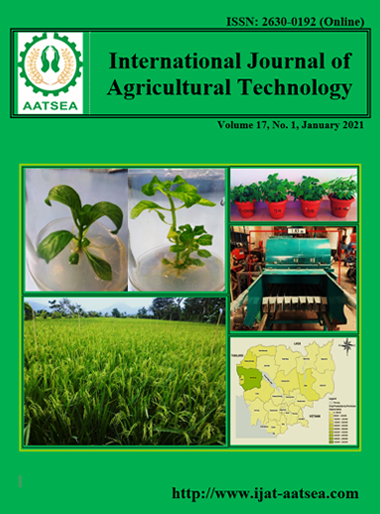Assessing students’ satisfaction towards agricultural learning services of the Royal Flora Ratchaphruek
Main Article Content
Abstract
The major findings revealed the students’ mean satisfaction level to be 4.33 out of the 5.00 maximum score, interpreted as they were very satisfied. This high satisfaction is because of the excellence of learning courses and services provided by the Royal Flora Ratchaphruek that can fulfill the students’ goals. The attending students stated their knowledge has enhanced with the up-to-date course contents applicable in daily life. Also, the altruistic and liberal nature of the instructors was considered being a beneficial and motivating factor for students to communicate both questions and ideas. However, the independent sample t-test revealed the statistically significant difference between male and female informants in terms of the mean value of satisfaction towards such agricultural learning services for the p-value < 0.05. Most means were found not statistically significantly different. Thus, this type of learning services should be established to inspire children to interest in agriculture. But edutainment’s components such as attractive environments and enjoyable activities similar to the Royal Flora Ratchaphruek’s must be integrated into the program. These components are vital not only get children to engage throughout the learning process but also let them explore the actual world of agriculture
Article Details

This work is licensed under a Creative Commons Attribution-NonCommercial-NoDerivatives 4.0 International License.
References
Baker, C. and Pasuk, P. (2009). A History of Thailand. 2nd ed. University Press. Cambridge.
Broccardo, L., Culasso, F. and Truant, E. (2017). Unlocking Value Creation Using an Agritourism Business Model. Sustainability, 9:1618.
Chaipan, N. (2016). Study of agrotourism in Northern Thailand: key success factors and the future of the industry. An independent study submitted in partial fulfillment of the Degree of Master of Science Program (Marketing), at Thammasat University, Thailand.
CTN (2012). International Horticultural Exposition Royal Flora Ratchaphruek 2012. Retrieved from https://www.chiangraitimes.com/events-activities/international-horticultural-exposition-royal-flora-ratchaphruek-2012/.
FAO (2015). Developing the knowledge, skills and talent of youth to further food security and nutrition. FAO. Rome.
FAO (2018). Country fact sheet on food and agriculture policy trends FEBRUARY 2018: Socio-economic context and role of agriculture. FAO. Rome.
Flores, F. (1993). Innovation by Listening Carefully to Customers. Long Range Planning, 26:95-102.
IMF (2020). The Great Lockdown: Worst Economic Downturn Since the Great Depression. Retrieved from https://blogs.imf.org/2020/04/14/the-great-lockdown-worst-economic-downturn-since-the-great-depression/
Itani, O. S., Goad, E. A. and Jaramilo, F. (2019). Building customer relationships while achieving sales performance results: Is listening the holy grail of sales? Journal of Business Research, 102:120-130.
Jamieson, S. (2004). Likert scales: how to (ab) use them. Medical Education, 38:1217-1218.
Khermkhan, J. and Mankeb, P. (2018). The agricultural tourism management in family business: case study of Rayong province in Thailand. International Journal of Agricultural Technology, 14:327-1334.
Kim, S., Lee, S. K., Dongmin, L., Jaeseok, J. and Moon, J. (2019). The effect of agritourism experience on consumers’ future food purchase patterns. Tourism Management, 70:144-152.
Learning Liftoff (2019). 5 Factors that Affect Learning [Study Results]. Retrieved from https://www.learningliftoff.com/5-factors-that-affect-learning/
Means, B., Toyama, Y., Murphy, R., Bakia, M. and Jones, K. (2010). Evaluation of evidence-based practices in online learning: A meta-analysis and review of online learning studies. US Department of Education. Washington DC.
Ninthaphan, R. (2013). Thai tourists satisfaction towards services marketing’s mix of Royal Park Rajapruek Chiang Mai. Ganesha Journal, 9:155-166.
OECD (2020). Factors of successful learning. Retrieved from https://www.oecd.org/education/ceri/factorsofsuccessfullearning.htm
Panpakdee, C. and Puangchaey, H. (2012). Practical Knowledge of Local Wisdom at the Sobsai basin, Nan Province, Thailand. Sor Chareon Press. Bangkok.
Pasawano, T. (2015). Results of enhanced learning with the edutainment format. Procedia - Social and Behavioral Sciences, 176:946-951.
Pintrich, P. R. (2003). A motivational science perspective on the role of student motivation in learning and teaching contexts. Journal of Educational Psychology, 95:667-686.
Pitchayadejanant, K. and Nakpathom, P. (2018). Data mining approach for arranging and clustering the agro-tourism activities in orchard. Kasetsart Journal of Social Sciences, 39:407-413.
Pulido-Fernandez, J. I., Carrillo-Hidalgo, I. and Mudarra-Fernandez, A, B. (2019). Factors that influence tourism expenditure in World Heritage Cities. An International Journal of Tourism and Hospitality Research, 30:1-17.
Sonnino, R. (2004). For a ‘piece of bread’? Interpreting sustainable development through agritourism in Southern Tuscany. Sociol. Ruralis, 44:285-300.
Srikatanyoo, N. (2007). Agrotourist needs and motivations: the Chiang Mai case. A report for Dhurakij Pundit University, Bangkok, Thailand.
Terano, R. and Mohamed, Z. (2013). Quality of life among farmers in selected granary areas in Malaysia. European Journal of Social Sciences, 41:100-110.
Thai Gerontology Research and Development Institute (2015). Situation of the Thai elderly 2015. Thai Gerontology Research and Development Institute Press. Bangkok.
Tullis, J. G. and Benjamin, A. S. (2012). Consequences of restudy choices in younger and older learners. Psychonomic Bulletin & Review, 19:743-749.
Yamane, T. (1967). Statistics: an introductory analysis, 2nd ed. Harper and Row. New York.


